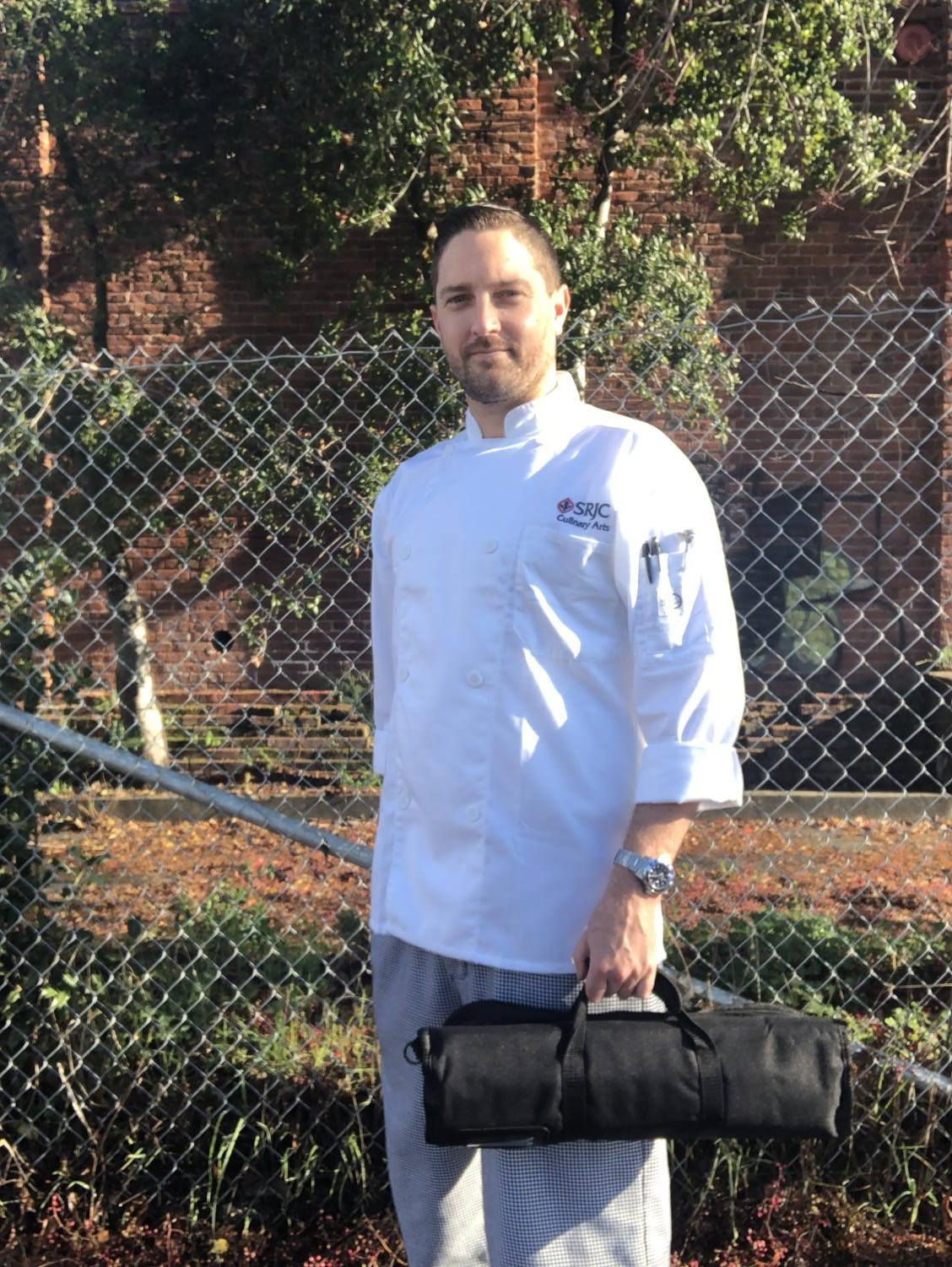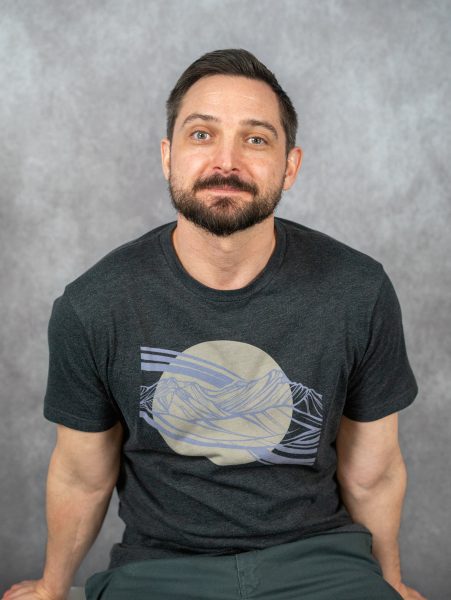Michael Hogle props his phone next to the kitchen sink and starts recording.
“I apply a moderate amount of soap into my palms and rub my hands together for 30 seconds, making sure they are fully enveloped in foamy lather,” Hogle explains to the camera as he demonstrates how to make suds. “Then I rinse my hands in warm water and dry them off with a clean towel. Now I’m ready to work in the kitchen.”
After saving the video, Hogle uploads it to Canvas and completes his first assignment in his Culinary Arts Sanitation and Safety class.
Hogle, 39, enrolled in the Santa Rosa Junior College culinary arts program in Fall 2021 in the middle of the COVID-19 pandemic. With most of his classes online, he has struggled to learn the hands-on skills necessary for his career.
“I’ve worked in the restaurant industry for 20 years, and there’s nothing that can prepare you for learning on a computer screen,” he said.
According to California Community Colleges data, more than 75,000 students like Hogle received a degree or certificate or completed a vocational apprenticeship last year statewide; nearly 5,000 of them attended SRJC. These students had to learn vocational skills without the use of tools, professional equipment, proximity to an experienced instructor and support from their classmates.
“It took me two hours to learn how to compress my hand washing video and upload it onto Canvas. Once you learn, it takes five minutes, but I’d never done it before,” Hogle said. “I almost needed a class to learn how to take my classes.”
Benjamin Goldstein, SRJC dean of agriculture, natural resources and culinary arts, said he had to cancel about 90% of the culinary arts classes when COVID restrictions began in March 2020 because the Burdo Culinary Arts Center was closed to the public. Then he and instructors had to switch the entirely in-person program to remote learning in order to continue in Summer 2021.
“We distributed supply kits with ingredients, small kitchen tools and appliances to students through a curbside system, created cooking videos and developed new and innovative ways of teaching remotely,” Goldstein said.
The culinary department awarded 89 students associate degrees in 2019, but despite its efforts, awarded only 11 in 2021, an 88% drop. Culinary arts is one of several vocational programs at SRJC, including automotive, diesel, machine tool and welding; vocational programs dropped 21% in total completions during the same period.
SRJC student enrollment is down 30% from 2019, which accounts for some of the drop in culinary art associate degrees but not all. While personal reasons may have kept some students away from college during the pandemic, Hogle suggests they may just not want to take culinary classes online.
While he still feels satisfaction from passing an online class, he isn’t sure if he actually grasped the content.
Beside problems common to all online classes, such as finding a quiet place to attend a lecture or missing it entirely due to a poor internet connection, Hogle said it would be impossible to take culinary classes without a good kitchen at home. Even students with kitchens don’t have the benefit of instructors helping them in real time.
“Online, the instructor isn’t looking over your shoulder telling you to turn down the heat or tasting your food to see if it was seasoned correctly,” Hogle said. “You also don’t get the personal interaction with the instructor. It’s all through email or text. I’ve had a couple of Zoom interviews, but it’s not the same as face-to-face.”
Betsy Fischer, culinary arts instructor and coordinator of the culinary career center, thinks students are missing out on more than cooking skills with remote learning.
“There are soft skills, like learning how to deal with guests in our restaurant. Or to learn teamwork and [how to] be in a building filled with professional kitchens and equipment,” Fischer said. “And if you’re going into the food and beverage business, you’ve got to be successful in teamwork because nobody works alone.”
Fischer believes students don’t form the camaraderie when they take classes online compared to in-person; students like to work in a restaurant because of the social environment. She has worked in the Burdo Culinary Arts Center since 2012 and compares it to a dormitory since students are there all day, multiple days a week.
“There’s that buzz,” she said. “The buzz is there when our retail bakeries are open. It’s even there on days we’re closed because students are running up and down the halls sticking their noses into rooms to smell something good.”
Hogle said he hasn’t built camaraderie with other students in his online classes.
“Instructors try to get students to interact online by responding to each other’s discussion posts on Canvas, but the students rarely go back to read the responses so a conversation never starts,” Hogle said. “You just know their name, but you’re not going to remember that.”
Building camaraderie during in-person classes is also difficult because everyone is wearing a mask, he said. He doesn’t think he’d recognize another student in public even if they were maskless.
Fischer also said the reduced enrollment in the culinary program has led to fewer students coming to her for employment.
“Prior to COVID I would probably speak with 10 to 12 students a month who would approach me looking for work. In the last six months I’ve probably had three students,” she said. “There’s no single reason for that. Students are reticent about going back to a public job during COVID. There are also students whose family situation has changed dramatically.”
Fischer said employers have been disappointed by the culinary program’s lack of output, but they understand the situation.
William Seppi, president and CEO of Costeaux French Bakery, has hired students from the SRJC culinary program for years, and he frequently reaches out to Fischer to fulfill his operation’s needs. He said there’s always been a need for new employees, even before COVID, and the lack of students coming from the culinary program has only increased that need.
“On the culinary side of our operation we usually hire two to three students a year from SRJC. Over the last two years, we haven’t had success getting any students or graduates,” Seppi said.
Seppi said he has had to change its hours of operation and limit the products offered at the restaurant because of his decreased workforce.
The labor shortage has hit restaurants across the nation. According to the National Restaurant Association 2022 summary, the total number of restaurant food service jobs dropped by 2.6 million from 2019 to 2020, and remain half a million jobs shy of recovering despite COVID-19 vaccinations and ease in social distancing restrictions.
As for Hogle, he just started cooking at Stark’s Restaurant in Ukiah after a former manager from his previous job put in a recommendation for him.
“I lucked out and got hired within an hour of applying,” he said.
He gets off work at 10 p.m. and finds it difficult to motivate himself to do homework, but he’s dedicated to getting his culinary program associates degree.
Hogle is also taking more in-person classes this semester where he won’t have to video record his progress from home.
“It’s all about being in-person,” Hogle said. “Without it I wouldn’t be confident going out in the real world.”





